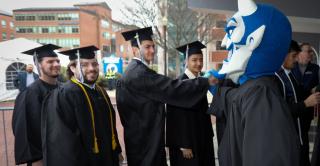
By Leslie Virostek
How will history remember COVID-19 and its effects on society? It depends on who is telling the story. Enhanced by the community-based fieldwork of the CCSU Public History program, Connecticut will have a rich, nuanced account of the pandemic as told by a diverse cross-section of residents.
The initiative is called the Community History Project, for which Central student interns are capturing 100 pandemic-related oral histories from teens, adults, and the elderly in communities of color around the state. Implementing what museums call “contemporary collecting,” the work addresses the need for the historical record to include the lived experiences and voices of underrepresented groups.
The Connecticut Historical Society (CHS) launched the project earlier this year in collaboration with Central, the Connecticut Digital Archive, and public libraries in Hartford, New Haven, and Norwich. It is funded by a grant of more than $200,000 from the Institute of Museum and Library Services.
Guests at the project's kick-off event on March 10 included students from Weaver High School in Hartford, whose oral histories were among the first collected. On display were COVID-19 artifacts, such as vaccine vials and a Dr. Anthony Fauci doll, as well as poster boards on which attendees could write their responses to questions such as “What was the worst part of the pandemic?”
Professor Leah S. Glaser, coordinator of CCSU’s Public History program, and Assistant Professor Juan Coronado, an oral historian, are overseeing the university’s participation. Glaser noted that the project is grounded in “the idea of shared authority, a central tenet of public history.” It's an approach that empowers community members to be the content experts, with academic historians acting as facilitators.
Glaser said project came about when CHS’s initial efforts to collect pandemic stories resulted in contributions from predominantly white, middle-class communities, rather than the groups most adversely affected. To capture the dissimilar effects of the pandemic on different populations in the state, CHS would have to actively solicit input from marginalized groups. CCSU’s Public History program, which trains students in exactly that kind of fieldwork, was an obvious partner.
CHS curator Ilene Frank said that the project builds upon an existing relationship with the CCSU History Department.
“We’ve had such great success in the past,” she says, noting that Central students have worked with CHS staff on a variety of projects over the years, including exhibitions. She adds, “We’ve always really loved the fact that we can [provide] a real-world experience for Central students while they are pursuing their degree.”
Among its provisions, the grant for the Community History Project funds two student internships over the course of four academic terms: spring, summer, and fall this year, and spring of 2023. Frank said project partners are impressed with the current interns, undergraduate Abigail Cowan and graduate student Peter Moran, who have done much more than collect oral histories.
“They have become essential project assistants,” she says. “They’ve played a dynamic role in logistics and public coordination. They’ve been phenomenal.”
Glaser stated that in addition to enhancing Central students’ educational experiences and career training, the project furthers the university’s commitment to community engagement and equity. She hopes one outcome will be to expand the public’s understanding of what museums and universities do and pave the way toward greater accessibility and inclusivity for underrepresented populations in both spheres.
Several years ago, the History Department’s efforts helped to put downtown New Britain on the National Register of Historic Places, conferring economic and other benefits to the city. Glaser sees Community History Project’s statewide impact as further demonstrating the relevance of history as a discipline and the role that university history departments can play to serve the public.
“It helps us get out of the ivory tower,” she says.



